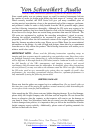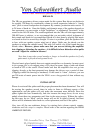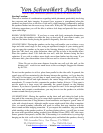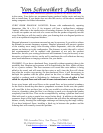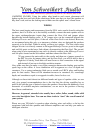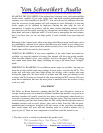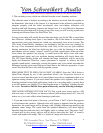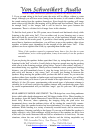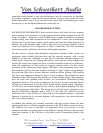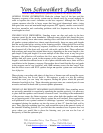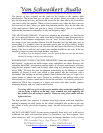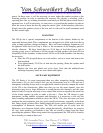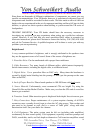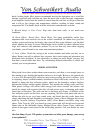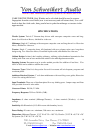
Von Schweikert Audio
930 Armorlite Drive, San Marcos, CA 92069
Ph (760)410-1650 Fax (760)410-1655
E-mail:albertvonn@aol.com
World Class Reference Speaker Systems for Music and Film
~ Website:www.vonschweikert.com
11
GENERAL TUNING INFORMATION: Both the volume level of the bass and the
frequency response of the woofer system can be altered easily by several methods in
order to equalize the room’s influence on the bass response. Although the VR bass
systems measure ruler flat in larger rooms that have good dimensional ratios, (using
both gated sine wave and maximum length sequence FFT signals), smaller rooms tend to
have bass anomalies and overloading problems with low frequencies due to the long
wavelengths involved.
STANDING WAVE PHENOMENA: Standing waves are dips and peaks in the bass
response caused by the room boundaries. Although many people have heard the term,
many don’t actually know what causes standing waves and what to do about them. Since
all speaker systems radiate bass almost omni-directionally, there are many path lengths
that the waves take before arriving at the listening position. Although the first arriving
bass wave will have flat frequency response, fractions of a second later the same waves
have bounced off of the front wall, rear wall, side-walls, and the floor. These reflections
both reinforce and cancel the original direct wave, depending on the wave-length vs. the
path length. If the path length is an even multiple of the direct wave at any one given
frequency, the reflection will reinforce the first wave since it will be mathematically
additive and will cause a peak in the response at this frequency. However, if the path
length is such that the reflected wave is out of phase with the main wave, there will be a
cancellation in the frequency response. Researchers have found that the dips and peaks
in the response can be very powerful, with 18dB variances across the bass range! Note
that this effect occurs with ANY speaker design: no speaker system can overcome the
law of physics.
When playing a recording with plenty of deep bass, a listener can walk around the room,
finding that every foot or two, there is flat response, a peak, or a dip. By walking
around the room, you can ‘map’ the response, finding the places where the pressure
alternates from high to low. These alternating pressure zones are a natural part of room
acoustics and must be dealt with by correct speaker placement.
THEORY OF RECIPROCITY REGARDING BASS RESPONSE: Since standing waves
are not easily amenable to correction by equalizing the speaker passively, it is necessary
to place both the speakers and listener/s in neutral zones. According to the mathematics
of the pressure zones, the flattest response occurs when both the speakers and listener
are at opposing ends of the room, directly against the wall surfaces. Since against-the-
wall placement is not a prime location for soundstage ‘openness’ and imaging focus, we
recommend placing the speakers out into the room, at least 12" from the back wall to
start. Then, playing a repeating bass line, walk around the room in the general vicinity of
the intended listening position. If you find that the smoothest bass response does not
occur where you would like to place the listening seat, you can use the Law of
Reciprocity to find the optimum spot.



